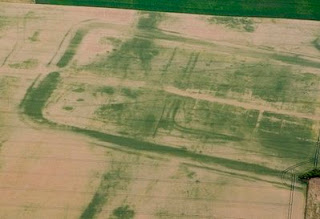(Bradford Abbas Roman Camp. One of the rounded corners of the Roman Camp and an entrance can be seen as a narrow green line in the field on the right hand side of the photograph. This ditch can then be traced as a faint line in to the adjoining yellow field to the left and forming another corner. ©English Heritage.NMR)
LONDON (REUTERS).- The exceptionally dry early summer months in Britain have revealed the ghostly outlines of several hundred previously unknown ancient sites buried in fields across the English countryside.
From Roman forts to Neolithic settlements and military remains dating to World War Two, English Heritage has been busily photographing the exciting discoveries from the air.
Known as crop marks, the faint outlines of unseen buried structures emerged because of the length of the dry spell, leading the national conservator to label 2010 a vintage year for archaeology.
The outlines show up when crops grow at different rates over buried structures. Shallower soils tend to produce a stunted crop and are more prone to parching, bringing to light the new features.
"It's hard to remember a better year," said Dave MacLeod, a senior investigator with English Heritage.
"Crop marks are always at their best in dry weather, but the last few summers have been a disappointment," he said.
"This year we have taken full advantage of the conditions. We try to concentrate on areas that in an average year don't produce much archaeology."
One of this year's most important finds is a Roman camp in Dorset, southwest England. Experts say it is a relatively rare structure in that part of the country with only three others known of in the region.
The lightly built defensive enclosure, which emerged from parched barley fields, provided basic protection for Roman soldiers on maneuvers in the first century AD.
In the Holderness area of the East Riding of Yorkshire, an area rich in agricultural land on the east coast, 60 new, mainly prehistoric sites, were found in just one day.
Archaeologists say at least 200 new historic sites have been discovered with detail on many more existing structures revealed for the first time.
At another Roman site for example, a fort at Newton Kyme in North Yorkshire, the crop marks showed stronger defensive walls built of stone three meters thick, together with a massive enclosing ditch.
English Heritage says some important structures have not been seen in their entirety since the scorching conditions of the 1976 drought.
(Writing by Stefano Ambrogi; Editing by Steve Addison)
From Roman forts to Neolithic settlements and military remains dating to World War Two, English Heritage has been busily photographing the exciting discoveries from the air.
Known as crop marks, the faint outlines of unseen buried structures emerged because of the length of the dry spell, leading the national conservator to label 2010 a vintage year for archaeology.
The outlines show up when crops grow at different rates over buried structures. Shallower soils tend to produce a stunted crop and are more prone to parching, bringing to light the new features.
"It's hard to remember a better year," said Dave MacLeod, a senior investigator with English Heritage.
"Crop marks are always at their best in dry weather, but the last few summers have been a disappointment," he said.
"This year we have taken full advantage of the conditions. We try to concentrate on areas that in an average year don't produce much archaeology."
One of this year's most important finds is a Roman camp in Dorset, southwest England. Experts say it is a relatively rare structure in that part of the country with only three others known of in the region.
The lightly built defensive enclosure, which emerged from parched barley fields, provided basic protection for Roman soldiers on maneuvers in the first century AD.
In the Holderness area of the East Riding of Yorkshire, an area rich in agricultural land on the east coast, 60 new, mainly prehistoric sites, were found in just one day.
Archaeologists say at least 200 new historic sites have been discovered with detail on many more existing structures revealed for the first time.
At another Roman site for example, a fort at Newton Kyme in North Yorkshire, the crop marks showed stronger defensive walls built of stone three meters thick, together with a massive enclosing ditch.
English Heritage says some important structures have not been seen in their entirety since the scorching conditions of the 1976 drought.
(Writing by Stefano Ambrogi; Editing by Steve Addison)
(Prehistoric circular enclosure)
(Newton Kyme Roman Fort, near Tadcaster, as revealed from the air)





No comments:
Post a Comment